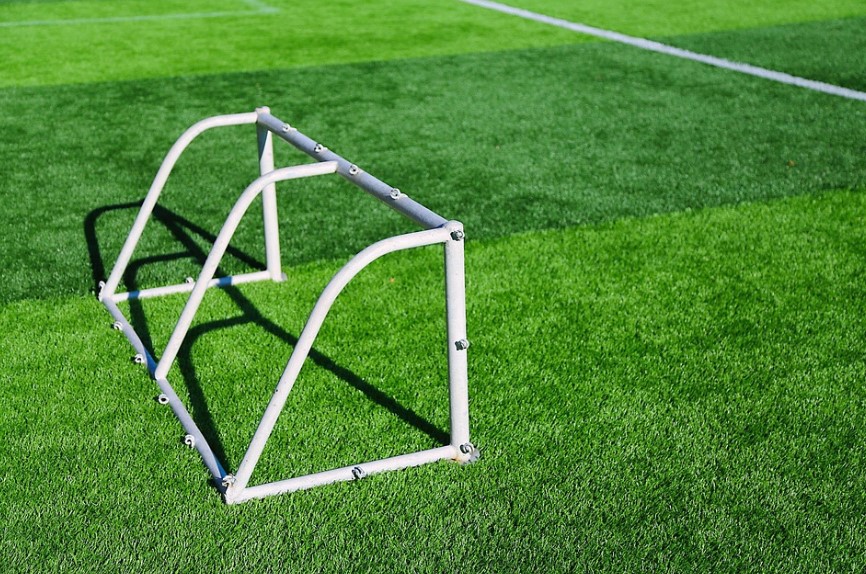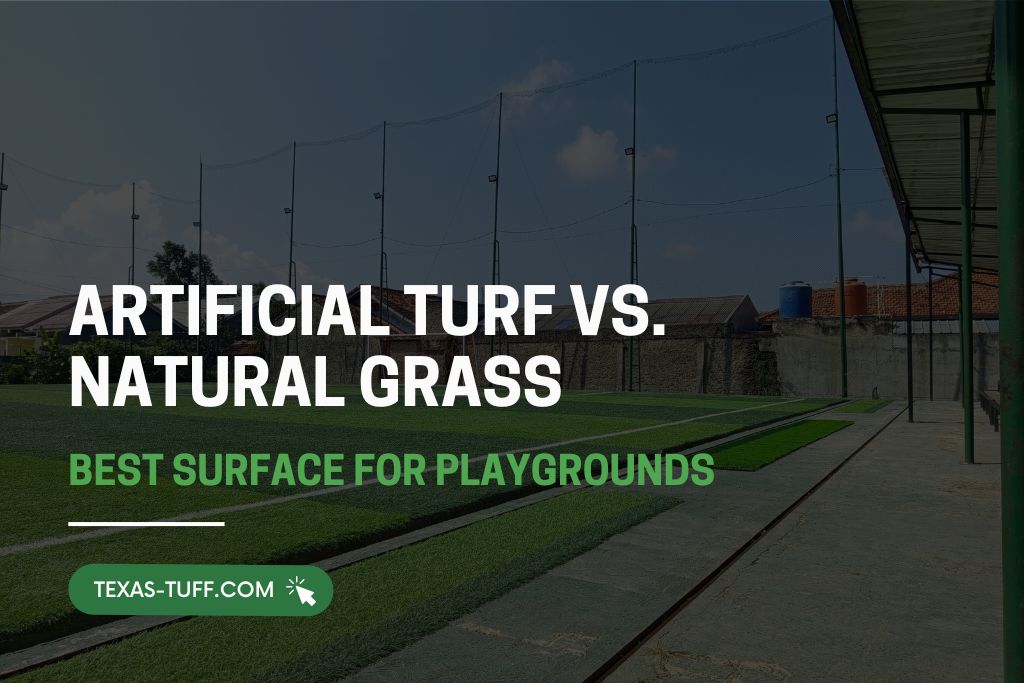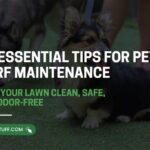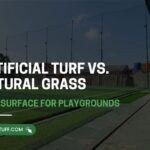If you’re planning a playground or sports field, choosing the right surface is crucial. The decision between artificial turf and natural grass can affect safety, maintenance, and how often the field can be used.
Not all surfaces are created equal. The right choice can make your playground safer, more durable, and more enjoyable for kids and athletes alike.
There are two main options for sports fields and playgrounds:
- Natural grass
- Artificial turf
Each has its own strengths and considerations. Picking the wrong type can lead to high maintenance, worn-out areas, and even safety hazards over time.
Texas Tuff artificial grass has helped many local organizations make the right choice for their playgrounds and sports fields. We will walk you through the main differences between artificial turf and natural grass, and what to consider before making a decision.
Choosing the right field surface can be simple, smart, and stress-free when you have the right information.
Table of Contents
Why Choosing the Right Playground Surface Is So Important
The surface of your playground or sports field isn’t just about looks; it’s about safety, durability, and performance. Choosing the wrong type of grass or turf can lead to injuries, high maintenance costs, and limited use.
Consider the impact of your choice:
- Safety First: Kids and athletes need a surface that reduces the risk of injuries from falls, collisions, or slips.
- Durability Matters: High-traffic playgrounds wear down quickly. A field that can’t handle heavy use will develop bare spots, mud patches, and uneven areas.
- Maintenance and Costs: Natural grass requires mowing, watering, fertilizing, and reseeding. Artificial turf reduces upkeep, but initial installation costs are higher.
- Year-Round Use: Rain, heat, or overuse can make natural grass fields unusable. Artificial turf allows play in nearly any condition.
- Performance: Athletes perform best on consistent surfaces. Uneven or patchy fields can affect running, ball bounce, and overall gameplay.
The best playground surface is one that balances safety, longevity, and usability. It’s about creating a space where kids can play, practice, and compete without worrying about the ground beneath them.
Artificial Turf vs. Natural Grass: Key Differences for Sports Fields
Choosing the right surface for playgrounds and sports fields can make all the difference in safety, playability, and long-term costs.
While both artificial turf and natural grass have their advantages, understanding the key differences will help you make an informed decision.
1. Durability and Wear
Artificial Turf:
- Designed to withstand heavy foot traffic, rough play, and constant use.
- Maintains its shape, color, and performance even with daily activity.
- Ideal for multi-purpose fields and areas that see year-round play.
Natural Grass:
- Can wear down quickly in high-traffic areas, leaving bare or patchy spots.
- Recovery requires reseeding, watering, and time—making it less practical for heavily used fields.
Pro Tip: If your field sees constant play, turf provides consistent performance without downtime.
2. Maintenance Requirements
Artificial Turf:
- Low-maintenance: occasional brushing, rinsing, and infill adjustments.
- No mowing, fertilizing, or watering required.
Natural Grass:
- High-maintenance: mowing, watering, fertilization, aeration, and pest control.
- Seasonal changes and weather conditions increase maintenance efforts and costs.
Pro Tip: Turf reduces long-term maintenance costs and frees up staff time for other tasks.
3. Weather and Drainage
Artificial Turf:
- Engineered with permeable backing to drain quickly, preventing puddles and muddy spots.
- Usable in almost any weather—rain, heat, or drought won’t significantly affect playability.
Natural Grass:
- Can become slippery or muddy after rain, limiting safe use.
- Dry or hot weather may cause browning, cracks, or uneven surfaces.
Texas Tuff Insight: In areas like Dallas-Fort Worth, with sudden storms and hot summers, turf ensures your field stays playable year-round.
4. Safety and Comfort
Artificial Turf:
- Provides consistent cushioning and a level surface, reducing the risk of trips and falls.
- Shock-absorbing layers can be added for extra protection on playgrounds and sports fields.
Natural Grass:
- Soft underfoot when healthy, but uneven areas, wet spots, or hard patches can increase injury risk.
Pro Tip: For kids’ playgrounds and high-impact sports, turf with a quality underlay is often safer than natural grass.
5. Long-Term Cost
Artificial Turf:
- Higher upfront investment but lower ongoing costs.
- Eliminates watering, fertilizers, reseeding, and frequent repairs.
- Lifespan: 10–20 years with proper care.
Natural Grass:
- Lower initial cost, but long-term maintenance, repair, and water expenses can add up.
- Recovery from heavy use may require downtime and additional labor costs.
Pro Tip: Always consider total cost of ownership, initial installation plus years of maintenance, when choosing a field surface.
Factors to Consider When Choosing Between Artificial Turf and Natural Grass
Selecting the right surface for your playground or sports field is about more than just looks. The best choice depends on how the space will be used, your budget, climate, and maintenance preferences.
Here are the key factors to weigh before making a decision:
1. Usage and Foot Traffic
- Artificial Turf: Ideal for high-traffic areas, multi-use fields, and spaces that host sports or playground activities daily. Maintains a consistent playing surface without downtime.
- Natural Grass: Works best for light to moderate use. Heavy traffic can quickly cause wear, bare spots, and uneven areas.
Pro Tip: Map out your field’s usage schedule. Frequent use favors turf, while occasional use may allow natural grass to thrive.

2. Maintenance and Labor
- Artificial Turf: Requires minimal upkeep; occasional brushing, cleaning, and infill adjustments. No mowing, fertilizing, or watering is needed.
- Natural Grass: Needs constant attention, including mowing, watering, reseeding, and pest control. Weather conditions can further increase labor demands.
Texas Tuff Insight: Turf reduces long-term labor costs, freeing staff to focus on other facility needs.
3. Safety and Cushioning
- Artificial Turf: Provides consistent surface quality, reducing the risk of trips and falls. Optional shock-absorbing layers enhance safety for kids and athletes.
- Natural Grass: Softer when healthy, but uneven patches, hard spots, or wet conditions can increase injury risks.
Pro Tip: For playgrounds or high-impact sports, consider turf with added padding for extra protection.
4. Climate and Drainage
- Artificial Turf: Drains quickly, resists heat, and stays playable in nearly all weather conditions. Won’t brown during droughts or get muddy after rain.
- Natural Grass: Vulnerable to weather extremes; heavy rain can create puddles, while heat and drought can damage or kill the grass.
Texas Tuff Insight: In climates like Dallas-Fort Worth, turf ensures year-round usability without worrying about weather-related damage.
5. Cost and Long-Term Value
- Artificial Turf: Higher upfront installation costs, but minimal maintenance and long lifespan (10–20 years) can make it more cost-effective over time.
- Natural Grass: Lower initial cost but ongoing water, maintenance, and repair expenses can add up. Recovery from heavy use may require downtime and additional labor costs.
Pro Tip: Always calculate the total cost of ownership, including installation, maintenance, and water usage, when comparing surfaces.
6. Aesthetics and Comfort
- Artificial Turf: Looks green year-round, with consistent texture and color. Some turf options mimic the feel of natural grass closely.
- Natural Grass: Offers a classic, natural look and soft feel but can vary in color, density, and texture depending on season and weather.
Texas Tuff Insight: If visual appeal is important, high-quality turf blends realism with durability, offering the best of both worlds.
Which Surface Is Best for Playground Sports Fields?
When deciding between artificial turf and natural grass, it helps to see how they measure up across key factors.
Here’s a side-by-side comparison for playgrounds and sports fields:
Factor | Artificial Turf | Natural Grass |
Durability | High; withstands heavy play without damage | Moderate; wears down under frequent use |
Maintenance | Low; occasional brushing, rinsing, and infill | High; mowing, watering, fertilizing, reseeding |
Safety | Consistent cushioning; optional shock-absorbing layer | Softer when healthy but uneven patches can increase injury risk |
Weather Resistance | Excellent; drains quickly, stays playable in rain or heat | Vulnerable; mud, puddles, or dry patches can limit usability |
Longevity | 10–20 years with minimal care | Depends on use, weather, and maintenance |
Cost | Higher upfront cost; lower long-term cost | Lower upfront cost; higher ongoing maintenance expenses |
Aesthetics | Green year-round; realistic textures available | Natural look; color and density vary by season |
Quick Recommendations
- Heavy-Use Playground or Sports Field: Artificial turf is often the smarter choice. It stays safe, durable, and playable year-round, even with frequent use.
- Light-Use or Recreational Areas: Natural grass can work well if maintenance and weather are manageable, and a softer, natural feel is preferred.
- High Safety Priority: Consider turf with a shock-absorbing underlayer for playgrounds to minimize injury risk.
- Budget-Conscious Projects: Factor in long-term maintenance costs, turf may have a higher initial price but saves money over time.
Making the Right Choice for Your Playground or Sports Field
Choosing between artificial turf and natural grass depends on how the field will be used.
Artificial turf stays consistent, safe, and ready for play in any weather. It requires little maintenance and performs well under heavy use.
Natural grass offers a softer, traditional look but needs regular watering, mowing, and repair. It’s better suited for light-use areas where upkeep is manageable.
For most playgrounds and sports fields in the Dallas-Fort Worth area, artificial turf provides better durability, safety, and long-term value.
Texas Tuff Artificial Grass helps schools, parks, and communities select and install the right surface for their needs. Our team understands the local climate and designs fields that last.
Contact Texas Tuff Artificial Grass today to choose the best surface for your playground or sports field.







